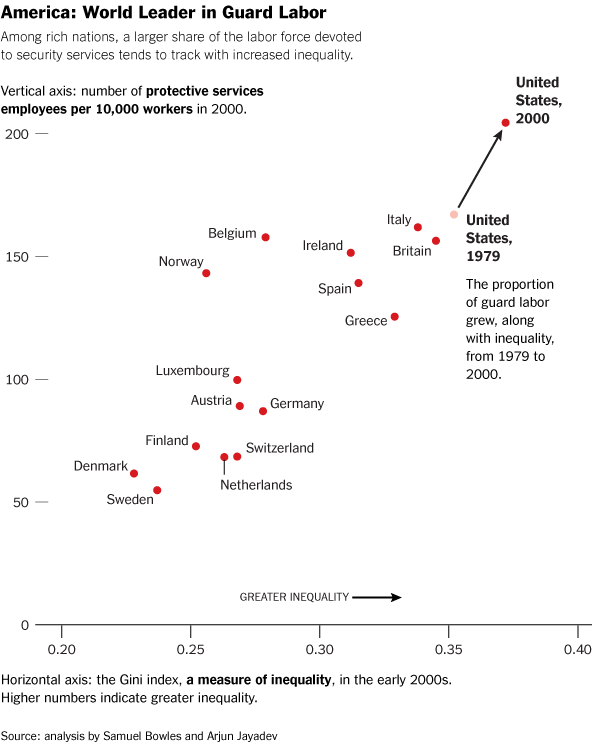There are now more people working as private security guards than high school teachers.
Samuel Bowles and Arjun Jayadev offer the following graph, highlighting the number of “protective service workers”* employed per 10,000 workers and the degree of income inequality in the year 2000 for 16 countries. The United States is tops on both counts.

Two things stand out from this graph beyond U.S. “leadership.” The first is the relationship between the share of protective service workers—or “guard labor”—and inequality. As Bowles and Jayadev comment:
In America, growing inequality has been accompanied by a boom in gated communities and armies of doormen controlling access to upscale apartment buildings. We did not count the doormen, or those producing the gates, locks and security equipment. One could quibble about the numbers; we have elsewhere adopted a broader definition, including prisoners, work supervisors with disciplinary functions, and others.
But however one totes up guard labor in the United States, there is a lot of it, and it seems to go along with economic inequality. States with high levels of income inequality — New York and Louisiana — employ twice as many security workers (as a fraction of their labor force) as less unequal states like Idaho and New Hampshire.
When we look across advanced industrialized countries, we see the same pattern: the more inequality, the more guard labor. As the graph shows, the United States leads in both.
The second is the rapid rise in the U.S. share of guard labor and inequality from 1979 to 2000.
One can only wonder in what ways and for whom this large and growing dependence on guard labor represents a rational use of social resources.
*For those who like definitions: The category protective service workers includes those employed as Private Security Guards, Supervisors of Correctional Officers, Supervisors of Police and Detectives, Supervisors of all other Protective Service Workers, Bailiffs, Correctional Officers and Jailers, Detectives and Criminal Investigators, Fish and Game Wardens, Parking Enforcement Workers, Police and Patrol Officers, Transit and Railroad Police, Private Detectives and Investigators, Gaming Surveillance Officers, and Transportation Security Screeners. A broader measure of guard labor might include members of the armed forces, civilian employees of the military, and those that produce weapons to those employed as protective service workers. That total was 5.2 million workers in 2011.
This post originally appeared on Sociological Images, a Pacific Standard partner site, as “Security Guards Now Outnumber High School Teachers.”




